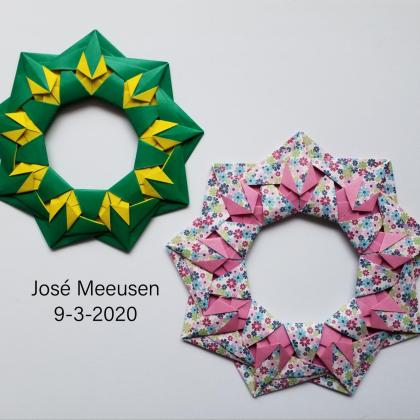Primary tabs
Creator

José Meeusen
Primary tabs
Dutch
English
Geometric
Modular
For permission to teach the model, please contact the copyright holder.
Netherlands
About José
HISTORY
Creativity is the common thread in my life, especially drawing and origami.
In 1981 I discovered origami. It was a new craft in my country, so I soon found myself teaching and promoting origami.
The first time I attended an international origami convention was in 1991. Meeting folders and designers from other countries opened a new world for me. It was the beginning of a worldwide correspondence. Those contacts were inspiring and encouraging; my design flourished. I wrote 6 Dutch origami books, won twice an award for my contribution to the Origami World Exhibition in Japan and my models are internationally published in magazines and books.
In the 2000s I still continued designing, but less frequently. I started to draw mandalas. It felt self-evident because my modulars are folded mandalas. I love to use a modular as a centerpiece of a mandala!
Once I got a computer I could reconnect with the origami world. Sharing my work became a lot easier.
MY WORK
Geometric origami, modular, and collapse folding meet my need for structure, balance, shapes, and the rhythm of repetition. I'm an admirer of the work of M.C. Escher, Islamic Geometric Patterns, and Celtic Knotwork and Spirals.
I love the beauty of simplicity and I like to explore the possibilities of creating nice models with a satisfying folding sequence. My modulars are nice on both sides and have a strong lock.
Investigating models to the full often results in a series of variations. Sometimes the last variation is a completely new model!
My favorite folding method is collapse folding for several reasons: the patience and perseverance of folding accurately all the pre-creases, the challenge of the collapse, and the surprise when everything falls into place. This brings me to my favorite designer and friend who had a big influence on my work: the late Jeff Beynon. By the way: my first design (1983) had a collapse!
I prefer to fold with plain paper, like kami, tant, elephant hide, and translucent paper, which shows best the beauty of geometry and holds the creases well. For models that show both sides of the paper, I use duo colour paper.
Creativity is the common thread in my life, especially drawing and origami.
In 1981 I discovered origami. It was a new craft in my country, so I soon found myself teaching and promoting origami.
The first time I attended an international origami convention was in 1991. Meeting folders and designers from other countries opened a new world for me. It was the beginning of a worldwide correspondence. Those contacts were inspiring and encouraging; my design flourished. I wrote 6 Dutch origami books, won twice an award for my contribution to the Origami World Exhibition in Japan and my models are internationally published in magazines and books.
In the 2000s I still continued designing, but less frequently. I started to draw mandalas. It felt self-evident because my modulars are folded mandalas. I love to use a modular as a centerpiece of a mandala!
Once I got a computer I could reconnect with the origami world. Sharing my work became a lot easier.
MY WORK
Geometric origami, modular, and collapse folding meet my need for structure, balance, shapes, and the rhythm of repetition. I'm an admirer of the work of M.C. Escher, Islamic Geometric Patterns, and Celtic Knotwork and Spirals.
I love the beauty of simplicity and I like to explore the possibilities of creating nice models with a satisfying folding sequence. My modulars are nice on both sides and have a strong lock.
Investigating models to the full often results in a series of variations. Sometimes the last variation is a completely new model!
My favorite folding method is collapse folding for several reasons: the patience and perseverance of folding accurately all the pre-creases, the challenge of the collapse, and the surprise when everything falls into place. This brings me to my favorite designer and friend who had a big influence on my work: the late Jeff Beynon. By the way: my first design (1983) had a collapse!
I prefer to fold with plain paper, like kami, tant, elephant hide, and translucent paper, which shows best the beauty of geometry and holds the creases well. For models that show both sides of the paper, I use duo colour paper.




